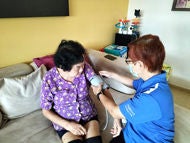What is - Neutropaenia
What is neutropaenia?
Neutropaenia (neutropenia) is a condition characterised by a low level neutrophils, a certain type of white blood cell, in the blood. Neutrophils are essential components of the immune system as they play a key role in defending the body against infections, particularly bacteria and fungi.

Neutropaenia can make individuals more susceptible to infections, as their bodies are less able to fight them off.
Symptoms of Neutropaenia
What are the symptoms of neutropaenia?
Neutropaenia does not directly cause any symptom. However, for people with severely low neutrophils (less than 500), they are at risk of getting infections. Possible symptoms include:
- Recurrent or prolonged fever
- Chills and sweats
- Recurrent or prolonged mouth ulcers
- Diarrhoea
- Pain during urination
- Tiredness
If you know that you have neutropaenia due to chemotherapy or blood disorder and have persistent temperature of more than 38 degrees or have other signs of infections, you should seek medical attention promptly.
Neutropaenia - Causes and Risk Factors
What causes neutropaenia?
- Medications: Drugs like chemotherapy, antibiotics or anticonvulsants can lower neutrophil counts by affecting bone marrow.
- Radiation exposure: Radiation therapy or accidental exposure damages bone marrow reducing neutrophil levels.
- Nutrient deficiency: Low folic acid and/or vitamin B12 can cause neutropaenia, although it is often present alongside anaemia (low red blood cell) and thrombocytopenia (low platelet count).
- Bone marrow disorders: Diseases like leukaemia or aplastic anaemia disrupt blood cell production leading to neutropaenia.
- Infections: Viral infections, such as COVID-19 and dengue, can suppress bone marrow function and reduce neutrophil production. Usually the neutropaenia is mild and self-limiting.
- Autoimmune diseases: Conditions such as lupus or rheumatoid arthritis cause the immune system to attack neutrophils.
- Genetic conditions: These are rare inherited disoders that result in low neutrophils since birth. Examples are several congenital neutropenia (Kostmann syndrome) and cyclic neutropenia.
Diagnosis of Neutropaenia
How is neutropaenia diagnosed?
The diagnosis of neutropaenia may involve the following:
- Full blood count: The healthcare provider will conduct a simple blood test to check various components, including a "differential" that looks at different types of blood cells. Neutropaenia is often classified into different severity levels based on the absolute neutrophil count in a blood sample.
- Mild neutropaenia: Between 1,000 and 1,500 neutrophils per microliter
- Moderate neutropaenia: Between 500 and 1,000 neutrophils per microliter
- Severe neutropaenia: Less than 500 neutrophils per microliter
- Other blood tests: Your doctor may arrange for other blood tests to find out the cause of
- Bone marrow aspiration and biopsy: In instances where doctors suspect a blood disorder, they may arrange a bone marrow biopsy. This involves taking a small sample from the patient's bone marrow and then examining it under a microscope.
Treatment for Neutropaenia
How is neutropaenia treated?
In most patients with neutropaenia, no treatment is needed especially if it does not cause them recurrent or severe infections.
In others, the treatment involves treating the underlying cause of the neutropenia. Treatments may include:
- Withholding or adjusting the medication that causes the neutropaenia.
- Growth factors (GCSF) to stimulate the bone marrow to produce more neutrophils. You will likely receive GCSF if your neutropaenia is due to chemotherapy.
- Replacement of folic acid and/or vitamin B12 if they are found to be low.
- If your neutropaenia is due to an underlying blood disorder, such as leukaemia and aplastic anaemia, you may need chemotherapy.
- If your neutropaenia is due to an autoimmune condition, your doctor may prescribe you corticosteroids to dampen your immune system from attacking your own white blood cells.
- If you are known to be neutropaenic and are suspected to have an infection, your doctor will likely admit you to the hospital and start you on intravenous (into the blood) antibiotics.
FAQs on Neutropaenia
As neutropaenia predisposes you to infection, taking the precautions below may reduce your risk getting infected:
- Frequent hand washing
- Avoid close contact with sick people or crowded places
- Staying up-to-date with your vaccines
- Eat properly cooked meals
- Thoroughly wash fruits and vegetables before consuming them
- Maintaining a good oral hygiene
References
Jin, J., Lee, Y. M., Ding, Y., Koh, L. P., Lim, S. E., Lim, R., Tambyah, P. A., & Hsu, L. Y. (2010). Prospective Audit of Febrile Neutropaenia Management at a Tertiary University Hospital in Singapore. Annals of the Academy of Medicine, Singapore, 39(6), 453–459. https://doi.org/10.47102/annals-acadmedsg.V39N6p453
Neutropaenia. Blood Cancer UK. (n.d.). https://bloodcancer.org.uk/understanding-blood-cancer/blood-cancer-side-effects/neutropaenia/neutropaenia/
Centers for Disease Control and Prevention. (n.d.). Neutropaenia and risk for infection. Centers for Disease Control and Prevention. https://www.cdc.gov/cancer-preventing-infections/patients/neutropaenia.html
Low White Blood Cell Counts: Neutropaenia. Low White Blood Cell Counts | Neutropaenia | American Cancer Society. (n.d.). https://www.cancer.org/cancer/managing-cancer/side-effects/low-blood-counts/neutropaenia.html
Vaillant, A. A. J. (2024, June 7). Neutropaenia. StatPearls [Internet]. https://www.ncbi.nlm.nih.gov/books/NBK507702/
Chen, Y., Zhou, H., & Jiang, J. (2023). Knowledge, Attitude, and Practice toward Chemotherapy-Related Neutropaenia and Febrile Neutropaenia among Breast Cancer Patients Running Title: Kap of Chemotherapy Neutropaenia in Breast Cancer. https://doi.org/10.21203/rs.3.rs-3467964/v1
Contributed by
The information provided is not intended as medical advice. Terms of use. Information provided by SingHealth.




















